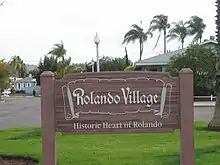32°45′43.16″N 117°03′40.30″W / 32.7619889°N 117.0611944°W


Rolando is a neighborhood of the Mid-City region of San Diego, California. Rolando is mostly residential with the exception of El Cajon Boulevard, which features the Campus Plaza shopping center. Rolando is divided by University Avenue into two sections: Rolando Village to the north, and Rolando Park to the south.
Geography
Rolando Village's borders are defined by College Avenue to the West, El Cajon Boulevard to the North, and University Avenue to the South. The eastern border with La Mesa is uneven, and is defined by several residential streets which lie between 67th and 73rd streets.
Rolando Park's borders are defined by College Avenue to the West, University Avenue to the north, the 94 freeway to the south, and the City of La Mesa boundary to the east.
Eight decorative public walkways known as "Catwalks" for pedestrians and joggers to travel between neighborhood streets are spread throughout Rolando.[2][3] They are:
- Paseo de los Agaves
- Paseo del Colibrí
- Paseo de los Coyotes
- Paseo de los Halcón
- Paseo de las Naranjas
- Paseo de las Palmas
- Paseo de los Papagayos
- Paseo de los Pinos
History
The history of Rolando, San Diego, traces back to its designation as ranch land for Mission San Diego de Alcalá by the Spanish provincial administration. In 1846, following the secularization of the mission system by the Mexican government, Don Santiago Argüello was granted the Rolando area. However, due to confusion over land titling arising from the Mexican-American War, the area remained unpartitioned for sale until 1885.[4]
Amidst California's rapid growth in the mid-1920s, Rolando gained attention as prime real estate when the city announced the paving of University Avenue from Euclid Avenue to La Mesa.[4][5]
In 1949, the Rolando Village Company, later renamed the Lincoln Homes Company, partnered with local contractor/developer Chris Cosgrove to commence development in the area. Rolando Park tract homes were swiftly constructed to meet the soaring demand for housing in Post-War San Diego.[5]
The 1950s brought forth concerns regarding school districts, infrastructure, and annexation. Rolando Park Elementary was established in 1951 and later sold to the San Diego Unified School District in 1955.[5]
In 1951, Robert O. Peterson opened the first Jack in the Box at 63rd Street and El Cajon Boulevard, pioneering the concept of a drive-thru restaurant with a two-way intercom.[6]
Residents of the former unincorporated area of Rolando Park voted to join the City of San Diego instead of La Mesa, leading to annexation in 1954 along with the sister community of Rolando.[5]
The 1984 Olympic Torch Run passed through Rolando Park on University Avenue.
In 2002, the Salvation Army's Ray and Joan Kroc Community Center opened its doors to the public.
Education
Rolando hosts two public elementary schools, one in Rolando Village and one in Rolando Park, both part of the San Diego Unified School District:
- Henry Clay Elementary School
- Rolando Park Elementary School
Clay Elementary shares fields with Clay Neighborhood Park in a joint-use agreement between San Diego Unified and San Diego Parks & Recreation.[7]
References
- ↑ "Ground Info". San Diego Cricket Association. Retrieved 2022-09-12.
- ↑ "Rolando Village Catwalks (East County) | San Diego Reader". www.sandiegoreader.com. Retrieved 2020-06-24.
- ↑ "Rolando catwalks connect residents and community - Some neighborhoods have simple sidewalks for residents and visitors to use for walking running and other exercise routines. However communities such as Rolando Village have winding "catwalks" and ..." www.sdnews.com. Retrieved 2020-06-24.
- 1 2 "Rolando History – Rolando Community Council". Retrieved 2023-12-11.
- 1 2 3 4 "Rolando Park History | Rolando Park Community Council". 2015-06-24. Retrieved 2023-12-11.
- ↑ Tutko, Marie (2017-05-31). "How Jack in the Box Became a Fast Food Pioneer". Hatch. Retrieved 2023-12-11.
- ↑ "Play All Day/Joint-Use". sandiegounified.org. Archived from the original on 2020-11-01. Retrieved 2022-09-12.